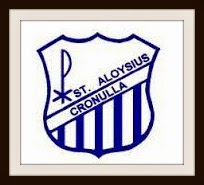We have had another wonderful day of learning and inspiration at St Joseph's Catholic Primary School. We were also lucky enough to have a familiar face visit, Sister Margaret Scroope.
What approaches are taken to cater for the diverse range of student learning needs?
-Flexible groupings in Mathematics for year five and six students.
-Teachers in Year Five collaborate and plan for Mathematics and students are grouped according to the content being taught and both teachers teach between the groups.
-Extension maths lessons for year five students.
-Quick smart program for struggling students.
Why are the learning environments engaging?
In Year Six today the students were working collaboratively on a HSIE project in the library. Using MacBook Pros they were asked to compose a music sequence that created emotion to be used as a background for the iMovie that will eventually become their final assessment for the HSIE unit and was a great way to incorporate the Multi modal aspect of learning. Through creativity, choice and technology this created an engaging learning environment for all students. There was also a strong element of peer to peer support with a number of groups providing each other with critical feedback.
There are clear expectations provided around the use of technology in the school and are displayed effectively when students are using technology.
Can you see elements of our own Contemporary Learning Framework at play in this school’s practice?
Today we saw an element of a culture of learning that builds capacity to deepen insight and meaning. The pedagogy witnessed gives students opportunities to problem solve, think critically and work creatively.
Things to take back to our own schools and classrooms:
-action research
-intervention programs
-technology links in learning
We have also shared with a few teachers at St Joseph's how we use the Early Learning Plan within our diocese and they were very impressed. It's a great tool for teachers in our diocese and has been something they would love to know more about.
Stay tuned for Day 4....
























Thank you team for this great post. It certainly appears you are fully engaged and seeing many things you can take back to your home school. I am pleased to note you have talked to them about some of our work (Early Learning Plans). This is a great opportunity to share with like minded, enthusiastic teachers. Make the most. Enjoy Day 4.
ReplyDeletePaul
Dear Anne Maree,
ReplyDeleteLooks like another busy day.
What does QS look like in the school? Who delivers this? and how is it linked to the class teachers planning ? Lots of questions!!!!
The basis of the Year 5 Maths extension - what is used to guild the planning?
Has this experience today have elements you can share with Christine?
Can you sneak a look at the their Creative Arts and bring back a gem as a springboards. (No pressure but as you are there!!!)
Ann
DeleteDear Ann
This is the first year of QS at this school. It is delivered by two learning support staff. Each tutor has 12 students who work with 6 groupings of 2 x half an hour 3 days a week. This is for the 30 weeks of the program. They do not commence QS until after first break and they work with a rotating timetable and that is how it is linked to classroom program's because the students are not consistently absent from the same lessons each day.
The basis of the Year 5 Maths extension - what is used to guild the planning?
Mathematics - whole analysis of the child
Agat and pat maths assessments
- had to be identified as gifted and talented not only in mathematics
- psychometric assessments
- achievement in the stage level
- still need to consider zone of proximal development as it is in all areas of maths
Has this experience today have elements you can share with Christine?
Students as part of HSIE at this school use AIM (achievement integrated model) from year 3. This model is about enhancing academic self-efficacy and metacognition skills. Students must as part of this process develop their own inquiry question to explore as part of the unit. It has a range of supports that can include models such as Bloom's Taxonomy, Kaplan etc to differentiate learning activities and uses an 'understanding by design' planning process around the syllabus outcomes.
Assessment and evaluation can include a range of rubrics, testing, learning/reflection journals (created in Google Docs), etc The daily learning journals are powerful with students reflecting on what went well, what didn't and the teacher is able to feedback through the journal.
Students present their work to a variety of audiences at the conclusion of the unit. The students present simultaneously each setting up their own area using a variety of multi-model designs to students from other classes. Yesterday we saw this at play in year 6 today in year 4. One of the students I sat with had created a PowerPoint for her presentation but was working on palm cards for any questions that came as a result of the presentation. Students and parent move freely from project to project and underperformance is also presented.
One of the program designers is working here at the school And I will add a link to the details in todays's blog.
DeleteAnn's right. Steal as much as you can really (in a professional way of course).
ReplyDeleteHi Anne Maree,
ReplyDeleteLooks like you have had another successful day. The posters you have attached to the blog are a fantastic focus for appropriate use of Technology.
What is the Library like? Do they have any ideas that would be useful for ours?
Noel
Hi Noel,
ReplyDeleteThe library is a good size and has lots of great furniture for kids to sit at to work and/or read. It also has a few stations with desktop computers.
We will take a few photos of the library and post them for you tonight.
Anne-Maree and Prue